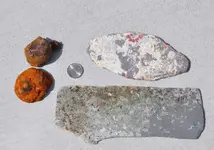RE: Treating Iron Found In Salt Water Locations
First immediate step is to fully immerse the objects in fresh water, (salt water is better than exposure to air, yet the salts are a primary concern and are one of the main elements requiring long term treatment). Next add a PH balance product, Sodium Carbonate, to neutralize the liquid environment and prevent further rapid oxidation. Sodium Carbonate is commonly found in the swimming pool supply department. The amount of Sodium Carbonate to add depends upon the size of the iron objects, as well as the amount of water volume to treat. Sufficient amounts of Sodium Carbonate added, should keep the water rather clear, and prevent the water turning rusty brown from leaching iron oxide. I've generally used about a tablespoon +/- per gallon, and then monitor to see if there is cloudiness after a few days, and add more Sodium Carbonate if needed. This first process is principally a primary stabilization process, prior to a more detailed treatment generally involving extended electrolysis.
The full instructions regarding steps to follow in electrolysis will be quite detailed and requiring more study and description than time allows at the moment. The soaking in fresh water with Sodium Carbonate is a must though, as soon as iron items are recovered, so as to prevent the rapid crumbling once the salts inside the porous iron begin to crystalize. Iron immersed in fresh water with Sodium Carbonate will remain quite stable, even after months or years.
The slate pieces may in fact be roofing slate, carried aboard ship to supply the building trade in areas, as well as provide ballast weight. Spain has long been a primary supplier of roofing slate. During past centuries, ships often carried marketable building supplies such as brick, and stone for ballast, when crossing the oceans to bring other valuable cargoes back to ports.
CC Hunter




